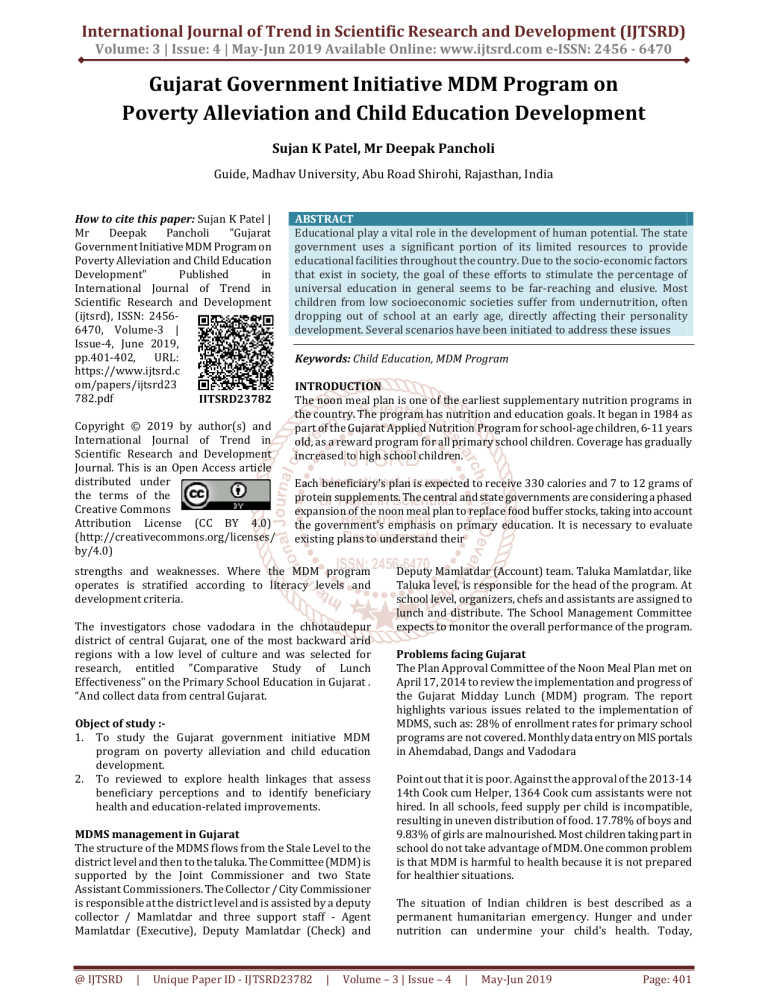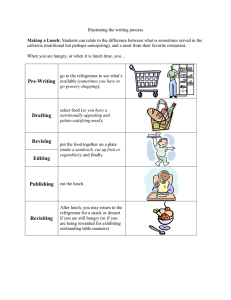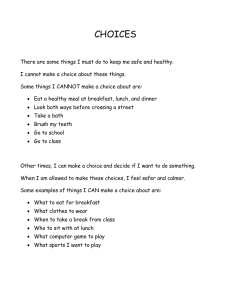
International Journal of Trend in Scientific Research and Development (IJTSRD)
Volume: 3 | Issue: 4 | May-Jun 2019 Available Online: www.ijtsrd.com e-ISSN: 2456 - 6470
Gujarat Government Initiative MDM Program on
Poverty Alleviation and Child Education Development
Sujan K Patel, Mr Deepak Pancholi
Guide, Madhav University, Abu Road Shirohi, Rajasthan, India
How to cite this paper: Sujan K Patel |
Mr
Deepak
Pancholi
"Gujarat
Government Initiative MDM Program on
Poverty Alleviation and Child Education
Development"
Published
in
International Journal of Trend in
Scientific Research and Development
(ijtsrd), ISSN: 24566470, Volume-3 |
Issue-4, June 2019,
pp.401-402,
URL:
https://www.ijtsrd.c
om/papers/ijtsrd23
782.pdf
IJTSRD23782
Copyright © 2019 by author(s) and
International Journal of Trend in
Scientific Research and Development
Journal. This is an Open Access article
distributed under
the terms of the
Creative Commons
Attribution License (CC BY 4.0)
(http://creativecommons.org/licenses/
by/4.0)
ABSTRACT
Educational play a vital role in the development of human potential. The state
government uses a significant portion of its limited resources to provide
educational facilities throughout the country. Due to the socio-economic factors
that exist in society, the goal of these efforts to stimulate the percentage of
universal education in general seems to be far-reaching and elusive. Most
children from low socioeconomic societies suffer from undernutrition, often
dropping out of school at an early age, directly affecting their personality
development. Several scenarios have been initiated to address these issues
Keywords: Child Education, MDM Program
INTRODUCTION
The noon meal plan is one of the earliest supplementary nutrition programs in
the country. The program has nutrition and education goals. It began in 1984 as
part of the Gujarat Applied Nutrition Program for school-age children, 6-11 years
old, as a reward program for all primary school children. Coverage has gradually
increased to high school children.
Each beneficiary's plan is expected to receive 330 calories and 7 to 12 grams of
protein supplements. The central and state governments are considering a phased
expansion of the noon meal plan to replace food buffer stocks, taking into account
the government's emphasis on primary education. It is necessary to evaluate
existing plans to understand their
strengths and weaknesses. Where the MDM program
operates is stratified according to literacy levels and
development criteria.
The investigators chose vadodara in the chhotaudepur
district of central Gujarat, one of the most backward arid
regions with a low level of culture and was selected for
research, entitled "Comparative Study of Lunch
Effectiveness" on the Primary School Education in Gujarat .
“And collect data from central Gujarat.
Object of study :1. To study the Gujarat government initiative MDM
program on poverty alleviation and child education
development.
2. To reviewed to explore health linkages that assess
beneficiary perceptions and to identify beneficiary
health and education-related improvements.
MDMS management in Gujarat
The structure of the MDMS flows from the Stale Level to the
district level and then to the taluka. The Committee (MDM) is
supported by the Joint Commissioner and two State
Assistant Commissioners. The Collector / City Commissioner
is responsible at the district level and is assisted by a deputy
collector / Mamlatdar and three support staff - Agent
Mamlatdar (Executive), Deputy Mamlatdar (Check) and
@ IJTSRD
|
Unique Paper ID - IJTSRD23782
|
Deputy Mamlatdar (Account) team. Taluka Mamlatdar, like
Taluka level, is responsible for the head of the program. At
school level, organizers, chefs and assistants are assigned to
lunch and distribute. The School Management Committee
expects to monitor the overall performance of the program.
Problems facing Gujarat
The Plan Approval Committee of the Noon Meal Plan met on
April 17, 2014 to review the implementation and progress of
the Gujarat Midday Lunch (MDM) program. The report
highlights various issues related to the implementation of
MDMS, such as: 28% of enrollment rates for primary school
programs are not covered. Monthly data entry on MIS portals
in Ahemdabad, Dangs and Vadodara
Point out that it is poor. Against the approval of the 2013-14
14th Cook cum Helper, 1364 Cook cum assistants were not
hired. In all schools, feed supply per child is incompatible,
resulting in uneven distribution of food. 17.78% of boys and
9.83% of girls are malnourished. Most children taking part in
school do not take advantage of MDM. One common problem
is that MDM is harmful to health because it is not prepared
for healthier situations.
The situation of Indian children is best described as a
permanent humanitarian emergency. Hunger and under
nutrition can undermine your child's health. Today,
Volume – 3 | Issue – 4
|
May-Jun 2019
Page: 401
International Journal of Trend in Scientific Research and Development (IJTSRD) @ www.ijtsrd.com eISSN: 2456-6470
according to recent orders from the Supreme Court, every
child who has attended a public school is entitled to a
nutritious meal. However, this right is far from being
realized: the coverage of lunch is close to universal, but the
quality of most states is still very low. Various
implementation issues have arisen in the states where lunch
has begun. Occasionally there have been reports of food
poisoning, especially in Pondicherry, where hundreds of
children have recently fallen ill after eating noon milk.
Teachers complain that a meal at noon will encroach on their
time or disrupt their classroom habits.8 Another example
comes from Delhi, where the Delhi High Court instructed 126
students to pay 400,000 rupees in January 2004 as
compensation. Government school food.
Many studies have reported on the improper
implementation of lunch. They suggested the importance of
the role of the teacher at lunchtime. But teachers' opinions
and experiences on lunch are completely different. Some
teachers said that lunch time has greatly increased their
workload.
They are expected to retain records of food and funds. Some
teachers are satisfied with the operation of the lunch in the
school. They reported that the lunch ended "classroom
hunger" and now the children are more focused. It directly
improves their academic performance.
Some teachers like to eat dry food during freshly prepared
lunches. They think it is easier to check the quantity and
quality of food given to children. A principal is very opposed
to the plan. He felt that there was no need to provide lunch
when the authorities were unable to provide adequate
drinking water at the school. The teachers also reported that
the lunch led to the interruption of the course. They
complain that the vision and smell of cooking food distracts
the children.
On the other hand, the teacher should “taste” the food in
front of the children, check that there are no outdated
ingredients, and whether the meal is healthy (rice and salt
will not do). The teacher should also supervise the child's
hand washing, and in the process can also see the child's
nails and general hygiene. The actual service and
consumption of the meal should be supervised by the
teacher for orderly and hygienic conduct. Chinese food can
also be used by teachers as a variety of educational activities;
educate children about good living habits and teach some
nutrition education.
@ IJTSRD
|
Unique Paper ID - IJTSRD23782
|
The universally applicable noon meal plan currently covers
nearly 12 children across the country, making it the largest
school feeding program in the world. However, issues
related to dietary quality continue to attract attention and
new monitoring and surveillance methods are needed. In
some cases, teachers were found to be exhausted, and then
they were unable to attend classes in the afternoon (Orissa).
In some states, teachers are forced to participate in a lunch
program, although the state government prohibits teachers
from participating in any activity other than learning. It has
also been found that some teachers are not aware of the
goals of the lunch program.
The study also found that some teachers believe that lunch
will affect teaching and learning. Therefore, efforts must be
made to make teachers aware of the advantages of providing
meals in schools as a means of improving the nutritional
status of children. It is therefore clear that teachers can play
an important role during lunch time.
Therefore, in order for lunch to become a complete universal
program, teachers must be properly positioned at lunchtime.
Every Indian child should actually get a free, delicious and
nutritious lunch. Therefore, research on the lunch plan for
teachers is very important.
Research methods are critical in the research process. It
describes the various steps taken to plan and addresses
research issues such as how the problem is developed,
definition of terms, choice of survey topics, validation of data
collection tools, data collection analysis and interpretation,
and process inference and generalization.
Teachers cannot prove that they teach and evaluate their
children's professions in these schools. In addition, a senior
teacher said that the quality of education will definitely be
affected. Students pass the exam whether or not they have
studied. This will make them affected in later life, when there
are competitive exams and medical or engineering entrance
exams.
REFERENCE
[1] http://emiguel.econ.berkeley.edu/assets/miguel_resea
rch/36/_Paper__Anemia_and_School_Participation.pdf.
[2] Naronha, C. And Samson,M.(2005).’’MDM in DelhiAfunctioning programme,’’ NewDelhi.N
[3] Naik, R. (2005).’’Report on Akshara Dasoha scheme of
Karnataka,’’ University of Dharwad, Karnataka.
[4] National Programme of Nutritional Support to Primary
Education, 2006 (Mid day Meal Scheme, Guidelines).
Volume – 3 | Issue – 4
|
May-Jun 2019
Page: 402





